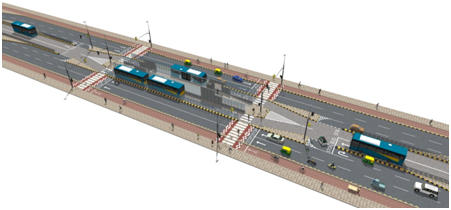|
Home  News News
New road safety design guidelines for Indian BRT Systems
|
25 October 2012 - Bus Rapid Transit (BRT) systems have emerged as a cost-effective, flexible, and environmentally sustainable form of public transportation. Several cities in India are currently developing or augmenting their BRT systems, with a special focus on improving their safety.
Bus Rapid Transit (BRT) systems have emerged as a cost-effective, flexible, and environmentally sustainable form of public transportation, and have come a long way since the world’s first system was developed in Curitiba, Brazil, and subsequently in other cities across Latin America. In India, BRTs have received considerable interest, and several cities are currently developing or augmenting their BRT systems.
Typically, a BRT system improves road safety because it segregates the movement of buses from all other transport modes, and introduces other changes in the road infrastructure that are associated with safety. These include shorter pedestrian crossings, and refuge islands. In particular, a central lane BRT system places the buses away from the paths of pedestrians and bicyclists, who are the most vulnerable road users. A well-executed BRT system can significantly reduce road accidents.
However, the perceived shortcomings of some poorly designed systems that can have the opposite impact on road safety if it fails to consider the negative impact on local accessibility and vehicular capacity, have highlighted the need for safer BRT infrastructure designs.
|
 |
In response, EMBARQ is developing design guidelines for road safety on Bus Rapid Transit corridors in Indian cities, with special consideration towards local accessibility and road traffic capacity. The guidelines include recommendations for street design, intersections, stations and station access, as well as transfers and terminals.
EMBARQ has gained significant expertise in conducting road safety audits on a number of BRT systems in India and other places, including those in Ahmedabad, New Delhi, Indore, Bogotá, Arequipa, Mexico City, and Rio de Janeiro. These guidelines have been developed out of these experiences, aimed at providing bus agencies, and transport planning organisations with a set of suggested design of BRT corridors.
|
|
Read more about India’s BRT safety systems.
|
|
|














